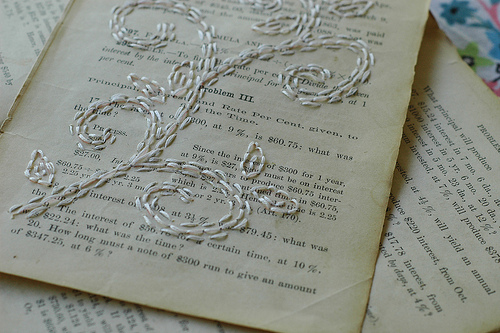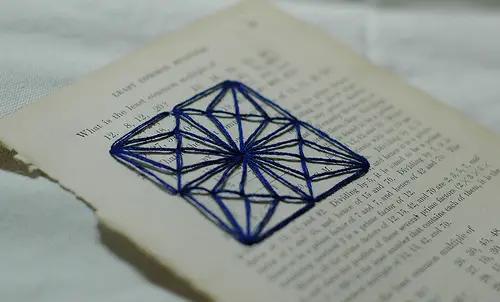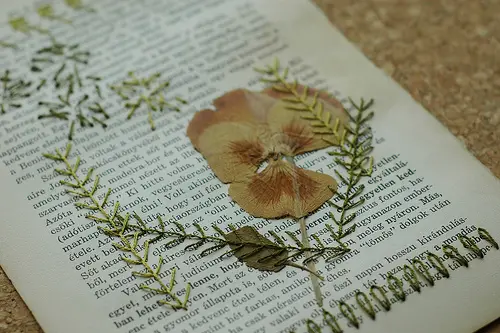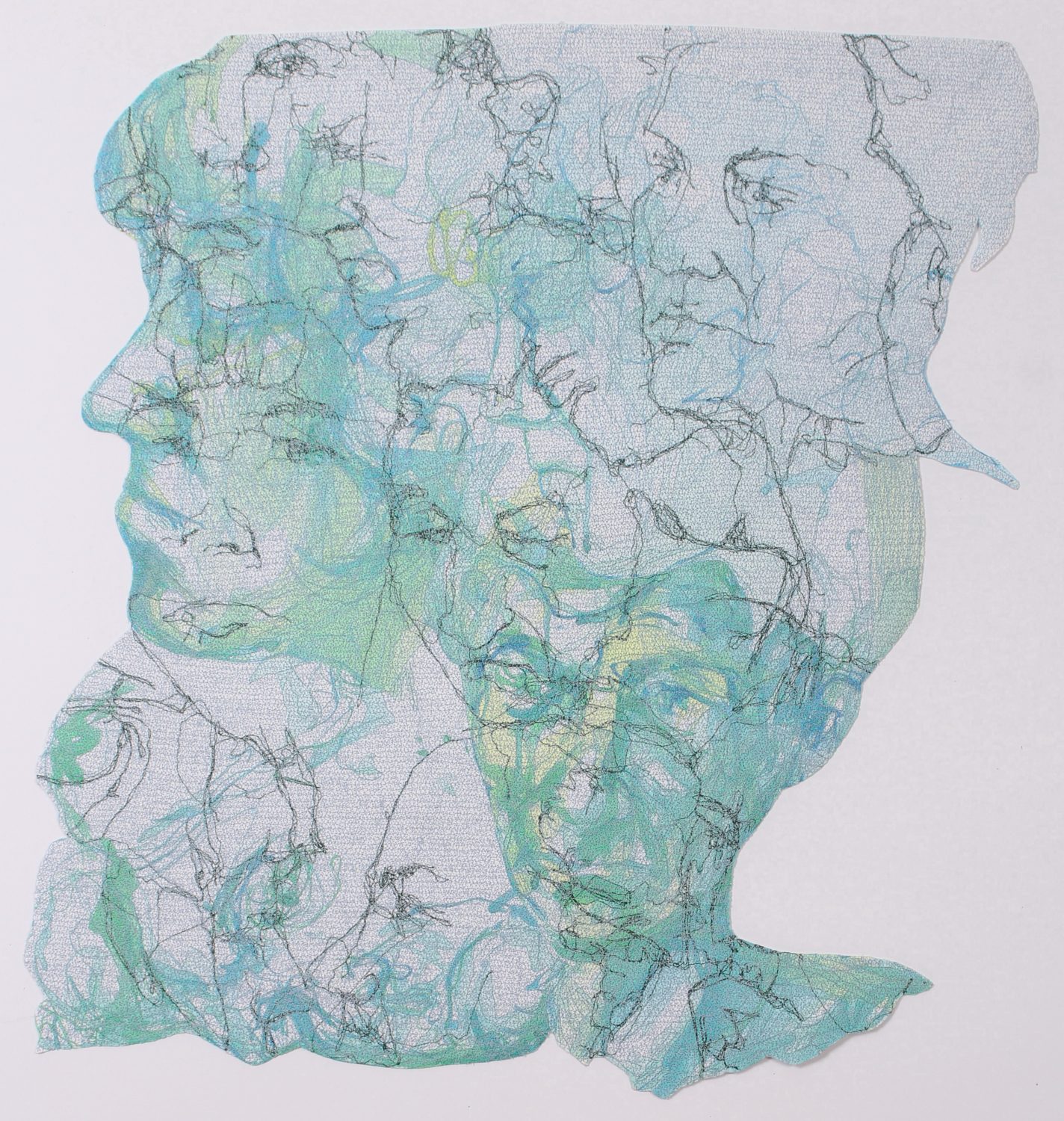Jessica Kelly’s work is delicate. She embroiders into vintage book pages. Her stitches are fine and light and seem to float above the yellowed pages in gossamer loops of thread.

Her muted floss colors are often nearly the same shade as her background pages, so the details of her designs take a while to come into focus. All of this gives her work an almost ethereal, breathless quality.
And yet… there is nothing precious about her vision or about the confidence with which she reclaims fading math books and transforms them into art.

A self-taught artist, Jessica lives and works in the suburban Washington, DC-area, with her husband and two children. She has been embroidering for about four years. I’ve been a huge fan of her artwork since I first saw her mesmerizing hexagons hovering atop a lost page from an old geometry book.
What follows is an exchange we had via email in June, 2014. Jessica is as articulate and precise in her conversation as she is in her artwork.

What is the story behind you picking up the needle and deciding, hey, I want to stitch into paper?
I started out embroidering as a way to personalize things for the people I love. I made onesies for new babies (including my own), and pillows for friends. I felt like I wanted to push farther — I wanted to go beyond just stitching up someone else’s pattern and create something that was just mine.
I started looking around on Flickr, paying attention to things I liked and didn’t like, and then one day I ran across this scorpion and it sort of triggered something in my head.

What is the appeal of vintage books for you?
I’ve had several old math books in my possession since college. I bought them at a library sale partially because I love math and partially because they were just plain interesting. My first thought was just to see how possible the mere idea of embroidering something on a page inside would be and in the end I just found the process to be really satisfying. I do have rules, I always check to be sure that the book isn’t rare, and that it’s freely available on google to read as a pdf. I look for books that have something interesting about them (and that have paper that feels up to handling being poked and stitched).

I am drawn to interesting illustrations, embossed elements, water damage, and inscriptions. I feel like each one has a bit of personality to it. I want to take a book that has had a good life and give it something new to be.

I find it interesting that you have only started considering yourself and artist in the last year, because I when I first saw your embroidery stitched into vintage book pages, it already looked so unique and accomplished.
My reluctance to call myself an artist is in large part all in my head. It just took some time to come around to feeling comfortable with it. Having other people refer to me that way made it easier, and repeating it to myself (like a little mantra) also helped. It feels right now.

Can you describe your first piece that you considered successful as artwork?
Looking back at things, the first piece that I really consider successful as artwork is Congruency: Variations on the Utility Graph. It has a story and a bit of meaning behind it.

In your earlier work, I see lots of geographic images (hexagons, etc.) on math pages. Now I’m seeing you use more organic shapes in your stitching (vines, curves, flowers, etc.) and some experimentation with found natural objects into your work. Have you seen this change yourself? Can you tell us anything about the transition?
Since the start I’ve been working with both geometric shapes and more organic lines. What I ultimately decide to stitch is partially a result of the books that I am currently working with. When using math book pages, my mind gets pulled in two directions: graph and group theory (I was a Math major, and these were some of my loves subject-wise) which lead to geometric results, and to the types of swirly, viney doodles I might have made in my own text and note books.

More recently, I’ve been working with a book of poetry and a cookbook, and these draw out a much different reaction from me. The poems in particular are quite sad and bring to mind the beauty that exists inside that kind of sadness.

Along with that, I am also trying to let myself relax and to get into some sort of flow instead of being such a meticulous planner in advance. With me and paper, there’s a tendency to feel a little too protective of a page, to find something too dear or too precious and be terrified of “messing it up”. I’m making attempts to push beyond that feeling, and have been working without a sketch made before-hand and sometimes without even knowing what I want to make. Some of these attempts are successful and some are not, but they all teach me something.

Can you tell us about the source materials for your embroidery designs? Do you keep a sketchbook? A clip file on your computer? How do you decide what imagery to stitch into your vintage pages? Do the shapes and designs come first or do the pages themselves provide the inspiration for what you embroider?
For the most part, I start with a page and then figure out what to put on it; very rarely do I have an image in my head prior to having a book page selected. I keep lists of topics that interest me, and of possible images that might go together well, but for the most part, the less constrained I let myself be when I sit down to make something, the better it turns out.

What, if any, inspiration or encouragement for your artwork do you gain from your interactions with other artists or in person? What role does your blog play in your creative process?

My blog (Paper Stitch) and other social media networks — flickr, instagram and twitter — have been integral in meeting and feeling connected to other artists. I love having a blog as a place to share what I’ve been working on! I also love seeing what other folks are making as well; I have a very long list of blogs that I try and keep up with. I’ve made some wonderful connections this way, and it’s what has kept me motivated to keep creating. For example, the support I’ve felt is what has really pushed me to keep moving forward and have the courage to submit works for gallery shows.

Jessica continues to push herself beyond the bounds of traditional embroidery. She has shown her work at the Ghost Gallery in Seattle and at a group show called Fiber: Exploring Today and Remembering Yesterday at the Verizon Gallery in the Earnst Cultural Center.
Her vision and her creative energy inspire me tremendously.






